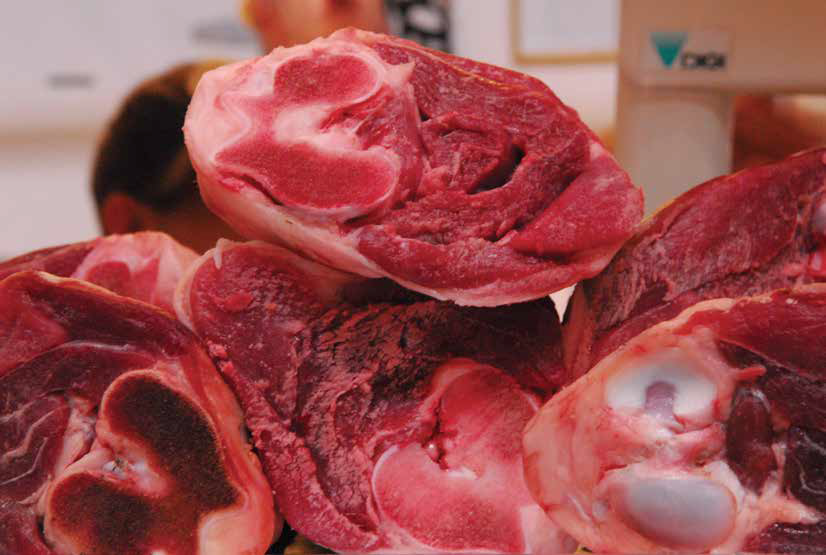Making Your Bones: The Fundamentals of Good Stock
There is nothing that is more essential to the understanding of cooking than stock. In fact, the French term for stock, “fond,” comes from the same Latin root word as “fundamental” and “foundation.” It is the basis on which all else is built.
The general public’s understanding of stocks has diminished in recent decades because of the advent of canned broths and bouillon cubes. These are pale imitators of their traditional counterparts, and the depth and interest a homemade stock can add to a soup or sauce is unmatched. This is not fancy food. On the contrary, stocks are the key ingredient to many peasant dishes, sauces, soups and stews. Many have forgotten or never learned how to make these building blocks of great food. They assume that it is too expensive and time-consuming for our modern, fast-paced world. While stocks often need to simmer on the stove for long periods of time, the attention needed from the cook is quite minimal. As for the cost, most stocks are made from leftovers and a few cheap vegetables. That is why they have been so popular with peasants throughout history.
Classical recipes for white and brown stocks can be somewhat involved, and require ingredients not easily found in today’s supermarkets. Three basic recipes can be used and varied to suit your needs and your pantry. Once a stock is finished, it can be kept in the refrigerator for 3-4 days, or in the freezer up to 6 months.
When freezing stocks there are two useful tricks. The first is to freeze in “Ziploc-style” freezer bags. Be sure to cool the stock, quickly and completely, before ladling into the bags. If you are worried about leaks, double-bag each one. Freeze them perfectly flat until they are solid; then they can be moved around as needed. Be sure to label each bag with a date and type of stock so that you’ll know how old and what kind it is. They can appear deceptively similar once frozen. Another nifty trick, especially for singles, couples or very small families is to freeze some stock in plastic ice cube trays. Once they are frozen solid (about 3 hours, usually) they can be turned out and placed in Ziplocs, to be used one at a time for small-batch sauces and much more.
Chicken Stock
A classical white stock is made from the breast meat of chicken, raw veal bones, chicken bones and aromatic vegetables such as leek, celery, carrot and onion. In this variation the classic is simplified, and it is extremely scalable – that is, it can be doubled or halved in volume easily.
Roughly chop 2 large yellow onions, 2 medium carrots and 3 stalks of celery. Combined, these three make up what is called a mire poix (pronounced “meer-pwah”). A mire poix is found in nearly all stocks and is usually in the ratio of 2:1:1 by volume of onion to carrot to celery.
Place these in the bottom of a large stockpot; 10-12 quarts is best for home stock making. Add all the bones, neck and giblets from a whole chicken. Add 2 sprigs of parsley, a crushed clove of garlic and 3-5 black peppercorns. Add enough water to cover and place on the stove over medium-high heat. Bring to a just simmer (do not boil!), then reduce heat to just barely maintain that simmer. Skim the foam and solids from the top and set a timer for one hour. Go about your business.
After an hour, come back and skim the surface again, and enjoy the marvelous aroma you have created. Set the timer for 1 hour again and go read a book. Repeat this process a third time, being sure to invite neighbors in so that they can enjoy the heavenly scents as well. At this point, taste the stock. It will be sweet and seem to need a lot of salt, but resist the temptation to add any salt. A stock’s flavor will change and intensify as it is cooked, so do not salt until the final soup or sauce is done and is about to be served otherwise it will be too salty in the end.
Cool the stock, strain through your finest strainer or cheesecloth, and store as detailed above. You may wish to refrigerate overnight, thus making it easy to remove the fat that will solidify on top, and then continue with the freezing process.
Variations: Try this recipe with the carcass from one of those ready-to-eat roasted chickens from the supermarket. Also, try using duck, pheasant or your holiday turkey. Adjust the amount of mire poix, approximately, to compensate for larger and smaller birds.
Beef Stock
Lightly coat 3-4 pounds of beef bones in olive oil. Choose bones that have a lot of exposed marrow – your butcher can help you select the right ones (By the way, if he or she cannot, then find another butcher). Place the bones in a shallow baking dish and roast in a 350°f oven for about 45 minutes. Turn them once or twice. When they are a rich brown, remove and place in a large stockpot with the same ingredients as with the chicken stock, above. It also goes through the same simmering process, but if the bones are larger it may take longer. Never be afraid to experiment, vary, or try new things.
Variations: For an even richer stock, use veal bones instead of beef. Lamb can be useful exclusively for lamb dishes. Also, a little red wine never hurt anything; a little for the stock, a little for the chef.
Fish Stock
Similar, but not quite the same as the first two, fish stock is a somewhat temperamental beast. First of all, use only the bones and head from lean white fish such as cod or snapper. Also, never use the gills; they produce a very bitter broth. Another major difference is to exclude the carrots, as they will discolor the broth. Most importantly, a fish stock should only simmer 30-40 minutes; overcooking can ruin the flavor irreparably. With those changes in mind, proceed with the same methods as before.
Variations: Try it with shrimp or lobster shells for extra richness. Add a little white wine or lemon juice if desired. Remember, never be afraid to experiment, try new things, and even make mistakes. Experience isn’t just the best teacher; it’s the only teacher.
*The Public Hearth is Edible’s effort to convey basic techniques to people who have never developed a passion for cooking, or never had the opportunity to learn. Beyond mere recipes, The Public Hearth seeks to help the beginning cook build a foundation of classical methods, professional “tricks of the trade,” and fundamental skills, with the hope that these lessons will then be shared. Our mission is simple: “Inspiring legions of cooks to inspire legions of cooks.”




